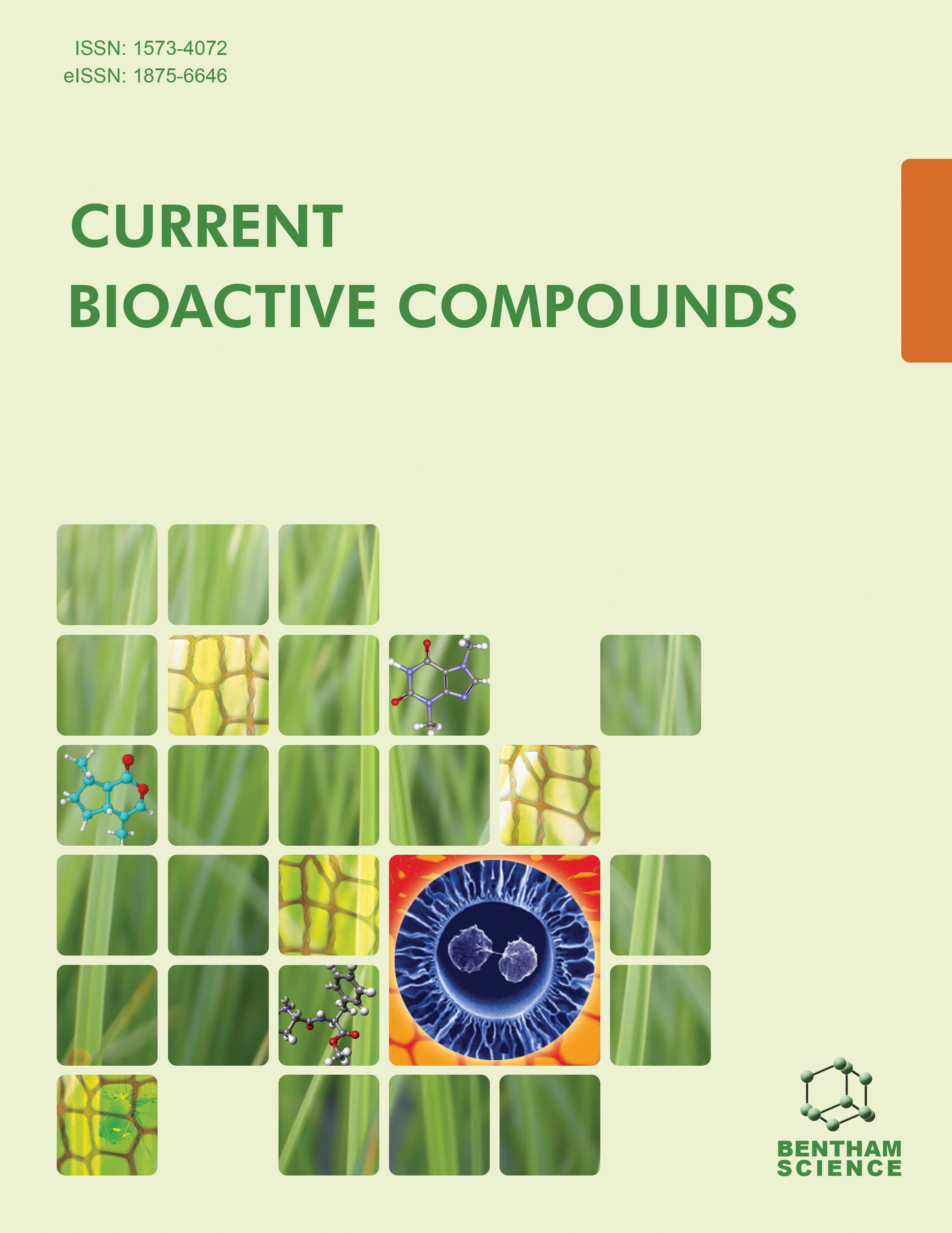- Home
- A-Z Publications
- Current Bioactive Compounds
- Previous Issues
- Volume 7, Issue 3, 2011
Current Bioactive Compounds - Volume 7, Issue 3, 2011
Volume 7, Issue 3, 2011
-
-
Editorial [Mini Hot Topic: Phytoestrogens - Analysis and Pharmacology (Guest Editor: Liselotte Krenn)]
More LessMid of the 1980ies, effects of natural compounds with estrogenic activity (phytoestrogens) in humans were discussed for the first time. Due to the discussion about the pros and cons of hormone replacement therapy (HRT) in menopausal and postmenpausal women, phytoestrogens have gained enormous scientific interest during the last two decades. The annual number of publications in this field raised from some thirty Read More
-
-
-
Phytoestrogens and their Putative Effects on the Aryl Hydrocarbon Receptor
More LessAuthors: Svjetlana Medjakovic and Alois JungbauerPhytoestrogens are highly bioactive compounds that modulate a wide range of signalling pathways. Among these are the aryl hydrocarbon receptor pathway and potential processes that are mediated by an activated aryl hydrocarbon receptor signalling cascade. Isoflavones and indoles have been reported to be dual modulators of the aryl hydrocarbon receptor and the estrogen receptor. The effect of these compounds Read More
-
-
-
Analysis of Lignans in Food Samples-Impact of Sample Preparation
More LessAuthors: Heidi Schwartz and Gerhard SontagIn this article an overview of the analytical methods in lignan analysis is given. Sampling, sample preparation (including extraction and hydrolytic sample work up), chromatographic separation methods and several detection modes are discussed and validation parameters like limits of detection and quantitation, recoveries, repeatability and linear range are compared. The challenges of lignan analysis are discussed, ad Read More
-
-
-
Lifelong and Prenatal Effects of Phytoestrogens
More LessAuthors: Oliver Zierau and Krista A. PowerMolecular and cellular effects of lifelong or even multigenerational exposure of phytoestrogens (PEs) are still controversially discussed and gain substantial public attention. While PE-rich diets may be preventive towards menopausal complications as well towards hormone dependent cancer formation, it seems as if late PE exposure at an advanced age results in increased risk of hormonal carcinogenesis in certain animal stu Read More
-
-
-
Muramyl Dipeptide and its Derivatives: Peptide Adjuvant in Immunological Disorders and Cancer Therapy
More LessAuthors: Chikako Ogawa, Yuen-Joyce Liu and Koichi S. KobayashiMuramyl dipeptide (MDP) is a synthetic immunoreactive peptide consisting of N-acetyl muramic acid attached to a short amino acid chain of L-Ala-D-isoGln. It was first identified in bacterial cell wall peptidoglycan as an active component in Freund's complete adjuvant. In the cell, MDP is detected by NOD2, a cytoplasmic receptor belonging to the human innate immune system. NOD2 mutations are frequently observed in Read More
-
-
-
Aβ Monomers, Oligomers and Fibrils: Structural Features
More LessAuthors: Cristina Airoldi, Erika Sironi, Barbara La Ferla, Francisco Cardona and Francesco NicotraThe misfolding, aggregation and accumulation of proteins in the brain, represents a common feature of diverse neurodegenerative diseases among which Alzheimer's disease (AD). Important therapeutic strategies for this pathology aim at inhibiting the aggregation of misfolded amyloid β (Aβ) peptides into different species, particularly intermediate oligomeric assemblies, which are believed to be the most neurotoxic speci Read More
-
-
-
Analgesic and Antipyretic Activities of Gindarudine, a Morphine Alkaloid from Stephania glabra
More LessAuthors: D. K. Semwal, Ruchi Badoni Semwal, Ravindra Semwal, Vishal Jacob and Gurjaspreet SinghGindarudine (GN), a morphine alkaloid isolated from the tubers of Stephania glabra (Menispermaceae), was evaluated for analgesic and antipyretic activities because of closely resembling structure to that of thebaine. The analgesic activity of GN was evaluated on albino mice by hot plate and tail immersion methods whereas antipyretic activity was studied on Brewer's yeast-induced pyrexia rats. Fever was induced by injecting Read More
-
Volumes & issues
-
Volume 21 (2025)
-
Volume 20 (2024)
-
Volume 19 (2023)
-
Volume 18 (2022)
-
Volume 17 (2021)
-
Volume 16 (2020)
-
Volume 15 (2019)
-
Volume 14 (2018)
-
Volume 13 (2017)
-
Volume 12 (2016)
-
Volume 11 (2015)
-
Volume 10 (2014)
-
Volume 9 (2013)
-
Volume 8 (2012)
-
Volume 7 (2011)
-
Volume 6 (2010)
-
Volume 5 (2009)
-
Volume 4 (2008)
-
Volume 3 (2007)
-
Volume 2 (2006)
-
Volume 1 (2005)
Most Read This Month
Article
content/journals/cbc
Journal
10
5
false
en

Most Cited Most Cited RSS feed
-
-
Podophyllotoxin: Current Perspectives
Authors: Ying Qian Liu, Liu Yang and Xuan Tian
-
- More Less

